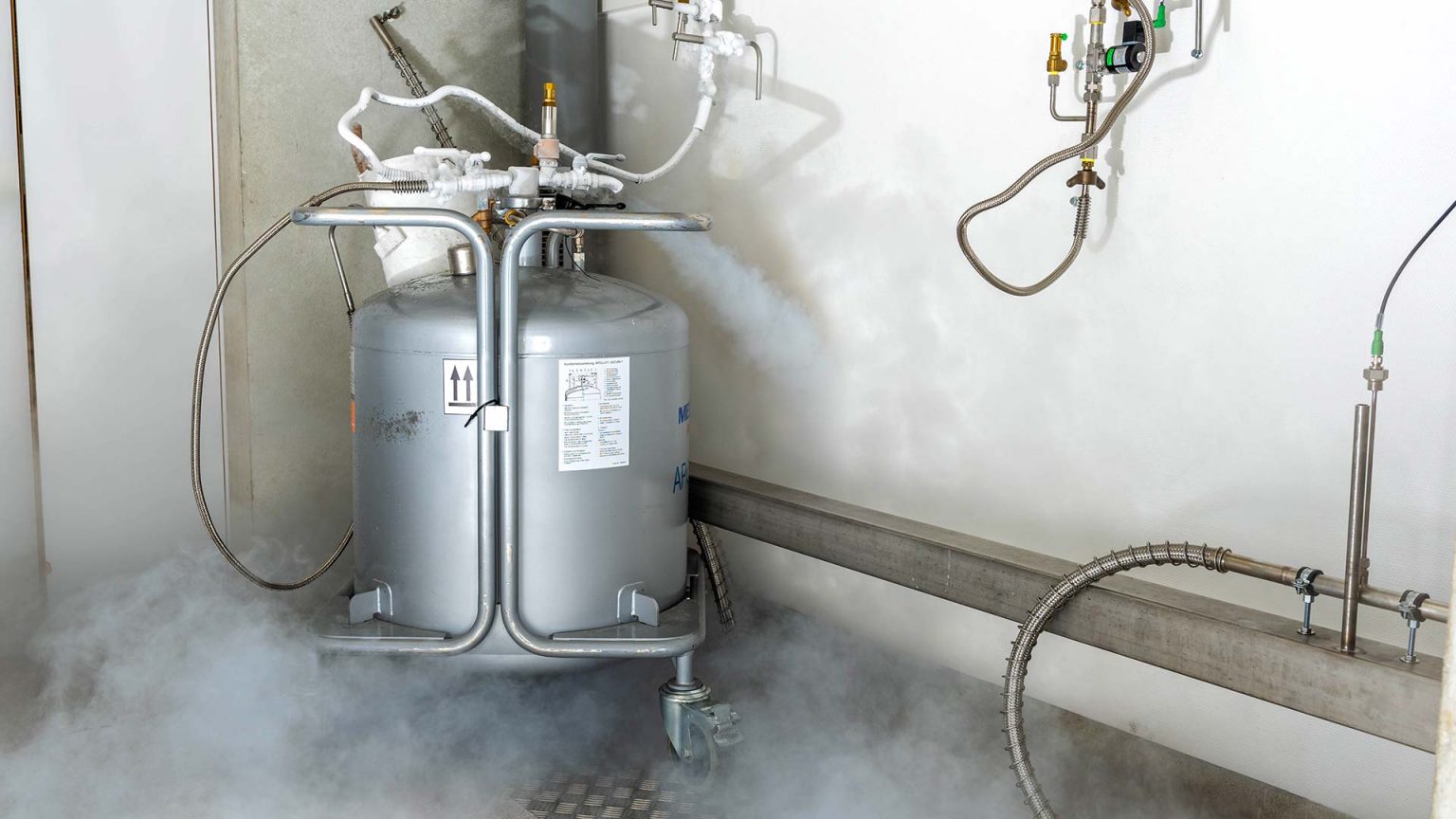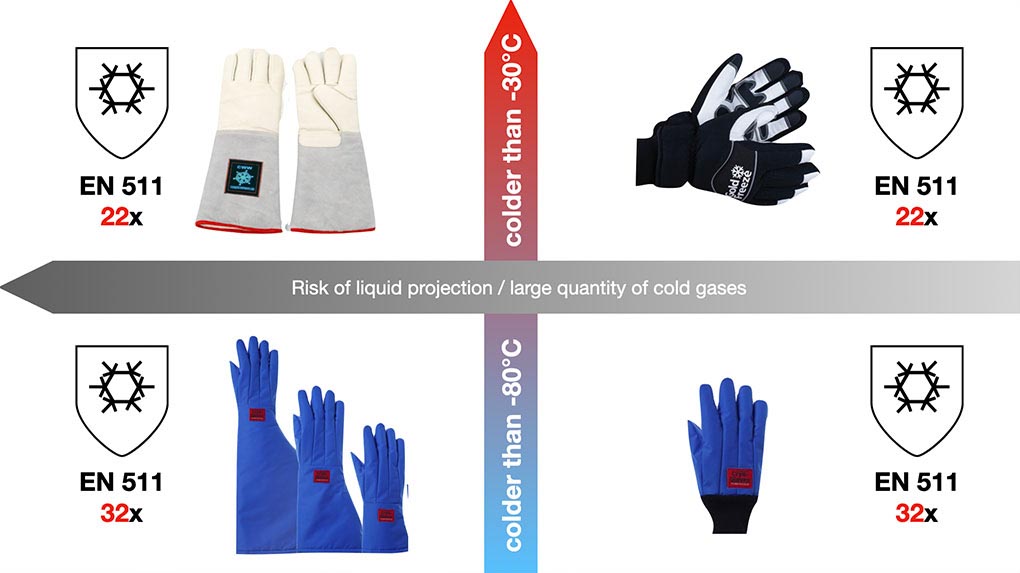
The two main cryogenics used on the campus are
• Liquid nitrogen, often abbreviated LN2,
• Liquid helium, often abbreviated LHe.
For other liquids (such as hydrogen), please contact us. Carbonic ice isn’t covered in this page.
In case of incident or gas/liquid leak
1. Evacuate the room
2. Call emergency number 115 or +41 21 693 30 00
Only the trained and equipped staff can intervene in case of emergency.
Liquid nitrogen and liquid helium are inert gaz, which decrease the oxygen content of the storage room. Contrary to assumptions, hypoxia and asphyxia are the main risks of cryogenics ! The slow boiling of these liquids in enclosed space reduces progressively the oxygen level thus increasing progressively the risk of fainting. Once fainting occurs, the risks of deadly asphyxia is the highest.
- I check my lab is ventilated enough
- If yes, I check and ask the installation of oxygen detector
- Pay attention to the ventilation cuts announcements and stop the work with cryo liquids if ventilation is not working.
- I design my experiment so inert gas is correctly evacuated
- I contact the OHS for each new experiment or when I significantly modify my experiment involving cryogenics
At EPFL, for laboratories manipulating and storing larger volumes of cryo liquids, a surveillance of the Oxygen rate is implemented.
In case of Oxygen deficiency, alarm will go off. At 19% O2 : visual alarm only. At the 18% O2 : visual + loud sound.
Evacuate the room immediately.
Cryogenic liquids , once evaporated, take 700 times more volume than when liquid. If they are not evacuated, these gas will increase the pressure within the room/container. The risk of explosion becomes substantial
- I check my dewar/experiment has a minimum of one (ideally two) safeguard for overpressure
- I install overpressure valves and rupture disks on critical point undergoing such pressure
Direct contact with cryogenics or cold surfaces/objects provokes burns similar to burns due to fire. Humid skin and mucous membranes stick to the surface that are cooled by these liquids.
- I protect my experience from any contact with the cold
- I protect myself with the appropriate protective equipment
Working in an environment where the temperature is lower than that of the office creates discomfort (loss of dexterity, concentration, etc.), even a health risk.
- I wear warm clothes at work
- I contact the OHS to optimize my work
The surfaces cooled by cryogenic liquids can in turn cool the surrounding gases sufficiently for them to condense. This is the case of oxygen in the air, which in contact with sufficiently cold metal surfaces will be liquefied and start to flow. Liquid oxygen is a well-known oxidizer and has been the cause of many fires, the best known example being the Apollo 13 mission.
- I protect my experiment from liquefying oxygen from the air
- I design my experiment so that the liquefied oxygen can be evacuated without touching flammable material
The properties of materials change greatly with temperature. The contraction of metals and the embrittlement of organic materials (plastics, rubber, etc.) can be both destructive to the equipment and to the people operating it.
- I choose the right materials for my research
- I check that the equipment is compatible with the cryogenic liquid I want to use
The use of cryogenic liquids requires completing corresponding specific safety training. This can be either online training with quiz or a classroom training.
Online training on cryogenic liquids safety for all schools except School of life sciences.
Online training on cryogenic liquids safety for School of life sciences.
Please note: after passing the test provided on the above link you are granted access to AI 0223 room.
Program & schedule of the next classroom cryo training
It is imperative to be trained and supervised by an experienced person when learning to handle these substances. This is responsibility of the research group. In general:
- I have a competent person validate any apparatus, experiment involving cryogenic liquids.
- I train my colleagues on the experiments I have built/implemented.
- I check and maintain my equipment according to current guidelines/standards or according to the equipment manual.
- I stop using any equipment that is suspicious, has defects or has not been maintained. I contact a competent person, in case of emergency the intervention team at 115 (021 693 30 00)
- In case of doubts I contact the OHS
Not all transport dewars are equal when faced with uneven ground. Only dewars that can be maneuvered on the road can actually be moved out of buildings. Handling dewars requires a minimum of experience.
- I always push cryogenic dewars during transport
- I get help to transport dewars if needed
- I ask for help to transport large capacity dewars (from 100L).
Videos illustrating filling of the dewars at cryo stations:
At least 2 people must be involved if you need to transport cryogenics in an elevator/ lift.
All cylinders travel ALONE in the elevators
At the starting floor, one person loads and sends the elevator to the destination floor where the second person waits to pick it up.
Access to the elevator is restricted during transport. The elevators are equipped with a band to block the access.
- If the band of the lift is missing or damaged, I contact the OHS.
The cryogenic liquid dewars must be maintained and controlled like any other equipment. Periodic inspection of safety systems can be done by the users. A more complete inspection should be done at least every five to ten years by specialized personnel.
- I find out when my dewars were last inspected
- I contact the company from which I bought my dewar to arrange a control/ maintenance
The choice of Personal Protective equipment (PPE) will depend on the temperature (see photo below) and type of manipulation.
As a general rule, in addition to the lab coat, long pants, closed shoes and safety glasses or face shield, it is advised to use the blue cryogenic gloves (EN 511, EN 388, EN 420) which have the highest level of protection. These gloves are certified down to -196 °C.
The blue gloves exist in water proof and non-water proof model (standard).
For applications such as: dispensing/transferring cryogenic liquids, removing samples from cryogenic liquids, use of any open cryogenic containers with the chance of exposure to liquids or splashes: it is advised to use water proof cryo gloves.
For applications such as: handling dry ice, low and ultra-low temperature freezers, closed cryogenic systems, you can use standard blue gloves.
NOTE: even though blue gloves are certified to -196 °C or water proof, they are not intended for immersion in liquid nitrogen or other cryogenic liquids. Indeed, no gloves from any supplier on the market are safe for immersion in cryo liquids.

If PPE inconforts me during experiments, I contact the OHS.